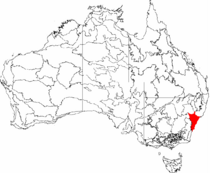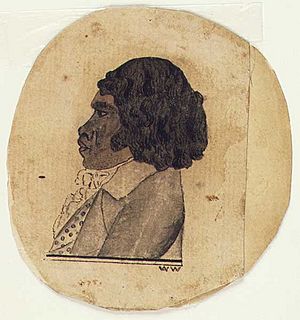Eora facts for kids
The Eora (also called Yura) are an Aboriginal Australian people from New South Wales. Early European settlers gave the name Eora to Aboriginal groups living along the coast of what is now the Sydney area. The Eora people shared a language with the Darug people, whose traditional lands were further inland.
When the first European settlers arrived, many Eora people sadly died from diseases like smallpox. These diseases were new to Australia and spread quickly. Even though their languages and ways of life were greatly impacted, the descendants of the Eora people live on today.
Scientists have found signs of human activity in the Sydney area for at least 30,000 years. Some stone tools found suggest people might have lived there even earlier, possibly 45,000 to 50,000 years ago.
Quick facts for kids Eora |
|
|---|---|
| aka: Ea-ora, Iora, and Yo-ra Eora (AIATSIS), nd (SIL) |
|

Sydney Basin bioregion
|
|
| Hierarchy | |
| Language family: | Pama–Nyungan |
| Language branch: | Yuin–Kuric |
| Language group: | Yora |
| Group dialects: | Dharug |
| Area | |
| Bioregion: | Sydney Basin |
| Location: | Sydney |
| Coordinates: | 34°S 151°E / 34°S 151°E |
| Notable individuals | |
Contents
What Does "Eora" Mean?
The word "Eora" has been used by non-Aboriginal people since 1899. It was originally thought to mean "men" or "people" in the local Aboriginal language. Early European records from the First Fleet often translated "Eora" this way.
For example, one officer wrote that "Eo-ra" was "the name common for the natives." Another record showed Bennelong using "Eora" to mean "black men," different from white men.
Today, Aboriginal people in Sydney also use "Eora" to refer to the Aboriginal people of the Sydney area. This shows how words can change meaning over time.
The Eora Language
The language spoken by the Eora people is called Dharug. There was an inland version and a coastal version, sometimes called Iyora or Eora.
Sadly, the language became mostly lost after the first two generations of European settlement. However, parts of it have been put back together using notes from early colonists. William Dawes learned much of the language from his friend Patyegarang.
Some Aboriginal words still used in Australia today come from the Dharug language. These include:
- dingo (from dingu)
- woomera (a spear-thrower, from wamara)
- boomerang (from wamarang and bumarit, which were names for fighting sticks)
- corroboree (a traditional dance, from garabara)
- wallaby
- wombat
- waratah (a flower)
- boobook (an owl)
- bogey (meaning "to bathe," from buugi-)
In December 2020, Olivia Fox sang part of Australia's national anthem in the Eora language. This happened at a big rugby match, showing the language is being revived.
Example Words in Eora
- babunna (brother)
- beenèna (father)
- Berewalgal (people from far away)
- doorow (son)
Eora Traditional Lands
The Eora people lived on lands with sandstone cliffs, coves, mangrove swamps, and rivers. Their territory was about 1,800 square kilometers (700 square miles). It stretched from the northern parts of Port Jackson up to the Hawkesbury River. To the south, it reached Botany Bay and the Georges River. Westwards, it went as far as Parramatta.
Their neighbors were the Kuringgai people to the north and the Darug people to the west. To the south, around Kurnell, were the Gwiyagal people, who were a northern clan of the Tharawal.
Eora Clans
The term Eora often refers to about 29 different clans. These clans usually had between 20 and 60 members, with an average of about 50. The ending -gal was added to a place name to show it was a clan from that area.
Some of the Eora clans included:
- Cammeraygal: Lived around Port Jackson, the North Shore, and Manly Cove.
- Wanegal: Lived south of the Parramatta River, from Long Cove to Rose Hill.
- Gadigal: Lived on the south side of Port Jackson, from South Head to Petersham. They were likely the main Aboriginal group in inner Sydney when Europeans arrived in 1788.
- Wallumettagal: Known as the "Snapper fish clan." They lived north of the Parramatta River, near Milson Point.
- Burramattagal: Known as the "Eel place clan," living at the source of the Parramatta River.
- Bidjigal: Lived around Castle Hill.
- Norongeragal: Their exact location is not known.
- Borogegal: Lived around Bradley Head.
- Garigal: Lived around Broken Bay or nearby to the south.
The Wangal, Wallumettagal, and Burramattagal were known as the three Parramatta saltwater peoples.
Eora Way of Life
The Eora people mostly lived along the coast and got much of their food from the sea. They were skilled at navigating in their bark canoes, fishing, and cooking. They did not farm crops, but the women gathered herbs for medicines.
They often used rock shelters for living, though many were later destroyed by settlers. They managed wetlands carefully, as places like Queenscliff and Dee Why lagoons provided lots of food.
In summer, they ate oysters and caught fish like mullet. They also caught larger fish with lines and spears from rock ledges. Turtle was a special treat as summer ended. In winter, they hunted animals like possums, echidnas, fruit bats, wallabies, and kangaroos.
The Eora people had rules for settling disagreements through battles. These fights would start late in the afternoon and stop soon after dark.
Eora History and European Arrival
When the first European colony was set up at Sydney Cove in 1788, the Eora people were confused by the settlers changing their land. There were many encounters as the Eora tried to protect their land and fishing areas.
Early on, Europeans took some Eora people to try and teach them English and act as go-betweens. Arabanoo was one of the first, but he sadly died in the smallpox epidemic of 1789. Later, Bennelong and Colebee were also taken. Colebee escaped, but Bennelong stayed and learned about the British. Governor Phillip even built a brick house for Bennelong at what is now Bennelong Point, where the Sydney Opera House stands.
When the First Fleet arrived in January 1788, there were about 1,500 Eora people. By early 1789, settlers started finding many bodies of Eora people. Canoes, once common, disappeared from the harbor. A smallpox epidemic in April 1789 greatly reduced the population. Some estimates say half of the Eora people died. This disease, along with a lack of food because their fishing areas were disturbed, led to a huge loss of life.
Despite these challenges, some Eora people survived. Governor Phillip chose not to get revenge after he was speared by Willemering in 1790. Governor William Bligh later wrote in 1806 that he saw Aboriginal people as the true owners of the land.
Governor Macquarie later set up a Native Institution to "civilize" Aboriginal and Māori children. Parents could only visit their children once a year. This institution was not successful, and many children suffered there. Aboriginal people continued to camp in central Sydney until they were forced to leave their camps in the 1880s.
Eora Song
An Eora song has survived from the past! It was sung by Bennelong and Yemmerrawanne at a concert in London in 1793. Their words and the music were written down by Edward Jones. You can even hear a modern version of the song online today.
Notable Eora People
- Bennelong: A Wangal man who helped connect the British colony with the Eora people. He traveled to England in 1792.
- Barangaroo: An important Cammeraygal woman and wife of Bennelong. She is remembered by the naming of the suburb Barangaroo.
- Patyegarang: An Eora woman who taught her friend William Dawes the Eora language.
- Arabanoo: One of the first Eora men taken by the First Fleet for training as an interpreter.
- Pemulwuy: A Bidjigal warrior who led the Eora resistance against the settlers for over ten years.
- Yemmerrawanne
- Tom Foster: A songwriter and expert in using boomerangs.
Other Names for Eora Groups
- Bedia-mangora
- Cammeray, Cammera
- Ea-ora, Iora, Yo-ra
- Gouia
- Gouia-gul
- Gweagal (Eora group on the south side of Botany Bay)
- Kadigal/ Caddiegal (group on south side of Port Jackson)
- Kameraigal (name of an Eora group)
- Kem:arai (place name for northern area of Port Jackson)
- Kemmaraigal, Camera-gal, Camerray-gal, Kemmirai-gal
- Wanuwangul (Eora group near Long Nose Point, Balmain, and Parramatta)
Images for kids
See also
 In Spanish: Eora para niños
In Spanish: Eora para niños



